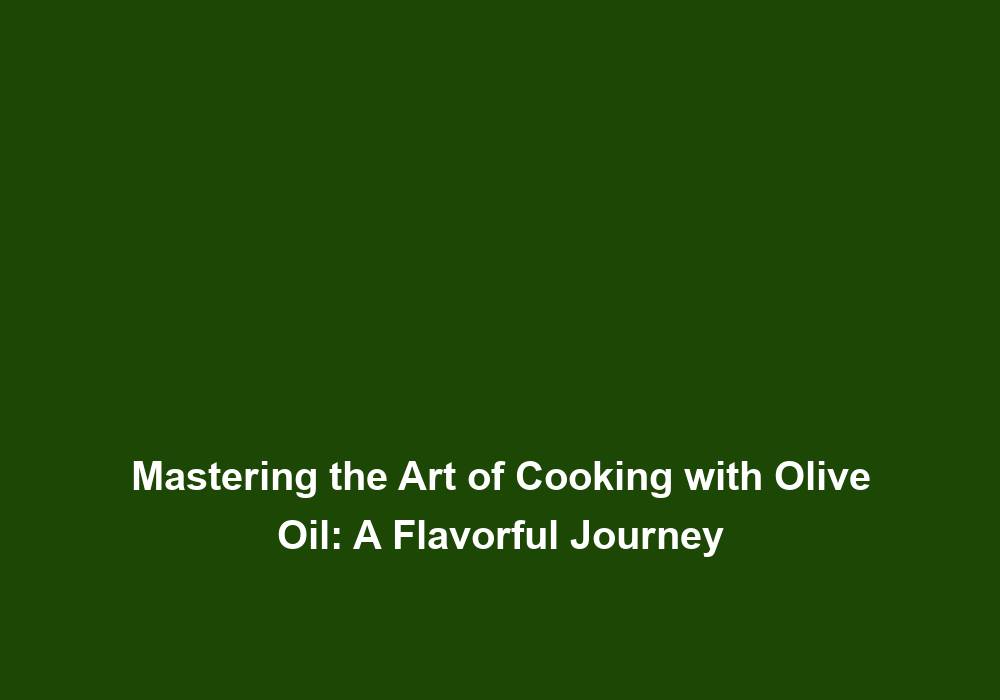Mastering the Art of Cooking with Olive Oil: A Flavorful Journey
Olive oil, with its rich history and remarkable versatility, has long been a staple in Mediterranean cuisine. It not only enhances the taste of your dishes but also offers numerous health benefits. In this article, we will delve into the art of cooking with olive oil, exploring its various uses, best practices, and tips to elevate your culinary skills. Let’s embark on a flavorful journey!
Why Choose Olive Oil?
Olive oil stands out among other cooking oils for several reasons. First and foremost, it has an exceptional nutritional profile and unique flavor. Olive oil is packed with monounsaturated fats, which are considered heart-healthy and can help lower bad cholesterol levels. These healthy fats are also known to reduce the risk of heart disease and stroke. Additionally, olive oil is an abundant source of antioxidants and anti-inflammatory properties, offering a wide range of health benefits. It can contribute to the prevention of chronic diseases such as cancer, diabetes, and Alzheimer’s.
Types of Olive Oil
To fully appreciate the art of cooking with olive oil, it is essential to understand the different types available:
-
Extra Virgin Olive Oil (EVOO): This is the highest quality and most flavorful olive oil, made from the first pressing of olives. EVOO has a low acidity level, rich aroma, and distinct taste. It is best used for drizzling over salads, dipping bread, and finishing cooked dishes. The vibrant green color and fruity flavor of EVOO can enhance the presentation and taste of your culinary creations.
-
Virgin Olive Oil: Similar to EVOO, virgin olive oil is also produced by purely mechanical means without any chemical refining. It has a slightly higher acidity level and a milder flavor compared to EVOO. Virgin olive oil is suitable for sautéing, roasting, and baking. Its delicate flavor allows it to complement a wide range of ingredients without overpowering them.
-
Pure Olive Oil: This type of olive oil is a blend of virgin olive oil and refined olive oil. It has a lighter flavor and is ideal for high-heat cooking methods such as frying and deep-frying. Pure olive oil has a higher smoke point, making it suitable for cooking at higher temperatures without breaking down or producing smoke.
-
Light Olive Oil: Contrary to popular belief, light does not refer to its calorie content but rather its mild flavor. Light olive oil undergoes extensive refining, making it suitable for recipes where the taste of olive oil needs to be minimal. It is often used in baking, where a neutral flavor is desired, or in dishes where the olive oil will be heated extensively.
Cooking with Olive Oil: Tips and Tricks
-
Choosing the Right Olive Oil for Cooking: When selecting olive oil for cooking, consider the dish’s flavor profile and desired cooking technique. EVOO is perfect for drizzling over salads and enhancing the flavors of cooked dishes. Its fruity and robust flavor can add depth to simple ingredients. Virgin olive oil works well for sautéing, as its milder flavor allows the other ingredients to shine. For high-heat cooking methods like frying, pure olive oil or light olive oil is suitable due to their higher smoke points.
-
Maintaining the Flavor of Olive Oil: Olive oil is delicate and can lose its flavor when exposed to heat or light for prolonged periods. To preserve its taste, store olive oil in a cool, dark place, away from direct sunlight. Consider using an opaque or tinted bottle to protect it from light exposure. Be sure to use it within a year of purchase for optimal flavor. If the oil starts to taste rancid or has an off-putting smell, it is best to discard it.
-
Using Olive Oil in Salad Dressings: Olive oil is a key ingredient in creating delicious and healthy salad dressings. Combine EVOO with balsamic vinegar, lemon juice, garlic, and Dijon mustard for a classic vinaigrette. Experiment with different herbs and spices to create unique flavor combinations. Consider adding a touch of honey or maple syrup for a hint of sweetness. Remember to whisk or shake the dressing vigorously to ensure the oil is well incorporated and emulsified.
-
Marinating with Olive Oil: Olive oil serves as an excellent base for marinades, infusing flavors into meats, vegetables, and seafood. Combine EVOO with herbs, spices, citrus juice, and garlic to create a flavorful marinade. The oil helps tenderize the ingredients and allows the flavors to penetrate deeply. Allow the ingredients to marinate for at least 30 minutes, or preferably overnight, in the refrigerator for maximum flavor. Remember to discard any leftover marinade that has come into contact with raw meat to prevent cross-contamination.
-
Sautéing and Roasting with Olive Oil: When sautéing or roasting, choose a pan or baking dish that can evenly distribute heat. Heat the olive oil over medium heat before adding the ingredients, ensuring they are not overcrowded. This allows for even browning and caramelization. For sautéing, use enough olive oil to coat the bottom of the pan without excessive pooling. When roasting, toss the ingredients in olive oil to ensure they are well coated. Consider adding herbs and spices to the oil for additional flavor.
-
Baking with Olive Oil: Olive oil can be used as a healthier alternative to butter or vegetable oil in baking. It adds moisture and a subtle fruitiness to baked goods. When substituting olive oil for butter, use a 3:4 ratio. For example, if a recipe calls for 1 cup of butter, use 3/4 cup of olive oil. Keep in mind that olive oil may impart a slightly different flavor and texture to the final baked goods. Experiment with different types of olive oil to find the one that best complements your desired outcome.
-
Finishing Dishes with Olive Oil: A drizzle of high-quality EVOO over finished dishes can elevate their flavors and add a luxurious touch. Use it as a finishing touch on soups, pasta, grilled vegetables, and roasted meats. The vibrant green color and distinct flavor of EVOO will enhance the presentation and taste of your culinary creations. Consider adding a sprinkle of sea salt or freshly ground black pepper to further enhance the flavors.
Conclusion
Mastering the art of cooking with olive oil opens up a world of culinary possibilities. Whether you want to create flavorful marinades, enhance the taste of your salads, or explore healthier cooking techniques, olive oil is a versatile and delicious choice. By understanding the different types of olive oil and implementing the tips and tricks mentioned, you can elevate your cooking skills and embark on a flavorful journey that will delight your taste buds and nourish your body. So, embrace the magic of olive oil and unleash your inner chef!







